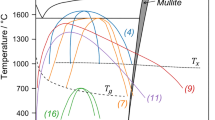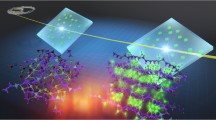Abstract
Although often regarded as a network-former in conventional silicate glasses, Al2O3 alone cannot be obtained as a bulk glass. Until now, glasses comprising continuously linked [AlOx] polyhedra have been prepared in only a few systems under very fast cooling conditions, which limits their dimensions to a few millimetres1,2,3. Yet it is desirable to prepare bulk, or monolithic, alumina-rich glasses, with the prospect of superior mechanical, chemical and optical properties4. Here we report a novel process for preparing very-high-alumina glasses and nanoscale glass-ceramics. Fully dense bulk articles in net shape are obtained through viscous sintering of glass microbeads. Additional heat treatment of the consolidated glasses leads to fully crystallized transparent glass-converted nanoceramics with a hardness similar to that of alumina. This method avoids the impracticably high applied pressures (more than 1 GPa) that have been required in most cases to prepare nanocrystalline ceramics by sintering, owing to the concurrent nature of densification and grain growth under pressureless conditions5,6. The reported techniques can be extended to form glasses and nanoceramics in other oxide systems that do not include a conventional glass-forming component.
This is a preview of subscription content, access via your institution
Access options
Subscribe to this journal
Receive 51 print issues and online access
$199.00 per year
only $3.90 per issue
Buy this article
- Purchase on Springer Link
- Instant access to full article PDF
Prices may be subject to local taxes which are calculated during checkout





Similar content being viewed by others
References
Sun, K.-H. Aluminate glasses. Glass Ind. 30, 199–200, 232 (1949)
Sarjeant, P. T. & Roy, R. in Reactivity of Solids (eds Mitchell, J. W., DeVries, R. C., Roberts, R. W. & Cannon, P.) 725–733 (Wiley, New York, 1969)
Weber, J. K. R., Abadie, J. G., Hixson, A. D., Nordine, P. & Jerman, G. A. Glass formation and polyamorphism in rare-earth oxide-aluminum oxide compositions. J. Am. Ceram. Soc 83, 868–872 (2000)
Weber, R., Nordine, P. C., Key, T. & Tangeman, J. in Proceedings of the SPIE – The International Society for Optical Engineering Vol. 4990 (eds Shibin, J. & Jacques, L.) 70–76 (SPIE – Int. Soc. Opt. Eng., Bellingham, WA, 2003)
Liao, S.-C., Chen, Y.-J., Kear, B. H. & Mayo, W. E. High pressure/low temperature sintering of nanocrystalline alumina. Nanostruct. Mater. 10, 1063–1079 (1998)
Chen, I.-W. & Wang, X.-H. Sintering dense nanocrystalline ceramics without final-stage grain growth. Nature 404, 168–171 (2000)
Klement, W., Willens, R. & Duwez, P. Non-crystalline structure in solidified gold-silicon alloys. Nature 187, 869–870 (1960)
Turnbull, D. & Cohen, M. H. Composition requirements for glass formation in metallic and ionic systems. Nature 189, 131–132 (1961)
Rawson, H. Inorganic Glass-forming Systems 23–29 (Academic, New York, 1967)
Jantzen, C. M., Krepski, R. P. & Herman, H. Ultra-rapid quenching of laser-melted binary and unary oxides. Mat. Res. Bull. 15, 1313–1326 (1980)
McMillan, P. & Piriou, B. Raman spectroscopy of calcium aluminate glasses and crystals. J. Non-Cryst. Solids 55, 221–242 (1983)
Shelby, J. E. Formation and properties of calcium aluminosilicate glasses. J. Am. Ceram. Soc 68, 155–158 (1985)
Yajima, S., Okamura, K. & Shishido, T. Glass formation in the Ln-Al-O system (Ln: Lanthanoid and ytrrium elements). Chem. Lett. (Jpn.) 8, 1313–1326 (1980)
Kawamura, Y., Kato, H. & Inoue, A. Full strength compacts by extrusion of glassy metal powder at the supercooled liquid state. Appl. Phys. Lett. 67, 2008–2013 (1995)
Waku, Y., Ohtsubo, H. & Inoue, A. A jelly-like ceramic fiber at 1193 K. Mat. Res. Innovat. 3, 185–189 (2000)
Sarjeant, P. T. & Roy, R. Ti4+ coordination in glasses in RO-TiO2 systems. J. Am. Ceram. Soc. 52, 57–58 (1969)
Inoue, A., Zhang, T. & Masumoto, T. Glass-forming ability of alloys. J. Non-Cryst. Solids 156–158, 473–480 (1993)
Shelby, J. E. & Kohli, J. T. Rare-earth aluminosilicate glasses. J. Am. Ceram. Soc 73, 39–42 (1990)
Angell, C. A. Structural instability and relaxation in liquid and glassy phases near the fragile liquid limit. J. Non-Cryst. Solids 102, 205–221 (1988)
Beall, G. H. in Advances in Nucleation and Crystallization in Glasses (eds Hench, L. L. & Freiman, S. W.) 251–261 (American Ceramic Society, Columbus, Ohio, 1971)
Rosenflanz, A. Fused Al2O3-Rare-Earth oxide-ZrO2 Eutectic Materials. US Patent 6,582,488 (2003)
Beall, G. H. & Pinckney, L. R. Nanophase glass-ceramics. J. Am. Ceram. Soc 82, 5–16 (1999)
Mizuta, H. et al. Preparation of high-strength and translucent alumina by hot isostatic pressing. J. Am. Ceram. Soc. 75, 469–473 (1992)
Yip, S. Nanocrystals: the strongest size. Nature 391, 532–533 (1998)
Kear, B. H., Liao, S.-C. & Mayo, W. E. High Pressure and Low Temperature Sintering of Nanophase Ceramic Powders. US Patent 6,395,214 (2002).
Freim, J., McKittrick, J., Nellis, W. J. & Katz, J. D. Development of novel microstructures in zirconia-toughened alumina using rapid solidification and shock compaction. J. Mater. Res. 11, 110–119 (1996)
Wilding, M. C. & McMillan, P. F. Polyamorphic transitions in yttria-alumina liquids. J. Non-Cryst. Solids 293–295, 357–365 (2001)
Bansal, N. P. Handbook of Glass Properties Ch. 11 (Academic, New York, 1986)
McMillan, P. W. in Glass-ceramics (eds Roberts, J. P. & Popper, P.) 196–200 (Academic, New York, 1979)
Acknowledgements
We thank C. Goodbrake (3M Company) for help with microscopy, and I.-W. Chen (University of Pennsylvania) for helpful comments during the preparation of the manuscript.
Author information
Authors and Affiliations
Corresponding author
Ethics declarations
Competing interests
The authors are all employees of 3M Corporation.
Supplementary information
Rights and permissions
About this article
Cite this article
Rosenflanz, A., Frey, M., Endres, B. et al. Bulk glasses and ultrahard nanoceramics based on alumina and rare-earth oxides. Nature 430, 761–764 (2004). https://doi.org/10.1038/nature02729
Received:
Accepted:
Issue Date:
DOI: https://doi.org/10.1038/nature02729
This article is cited by
-
Solution-combustion Synthesized Nano-pellet α-Al2O3 and Catalytic Oxidation of Cyclohexane by Its Supported Cobalt Acetate
Journal of Wuhan University of Technology-Mater. Sci. Ed. (2021)
-
Crystallization Mechanism in Spark Plasma Sintered Bulk Metallic Glass Analyzed using Small Angle Neutron Scattering
Scientific Reports (2020)
-
Crystallization kinetics of binary Yb2O3–Al2O3 glass
Journal of Thermal Analysis and Calorimetry (2020)
-
Femtosecond Laser Pulse-Induced Structural Modification of Lanthanum Aluminosilicate Glasses: Refractive Indices in Visible Vs. Terahertz Frequency Regions
Journal of Infrared, Millimeter, and Terahertz Waves (2020)
-
Microstructure dependence of ion transport in glass-nanocomposites
Journal of Electroceramics (2020)
Comments
By submitting a comment you agree to abide by our Terms and Community Guidelines. If you find something abusive or that does not comply with our terms or guidelines please flag it as inappropriate.



